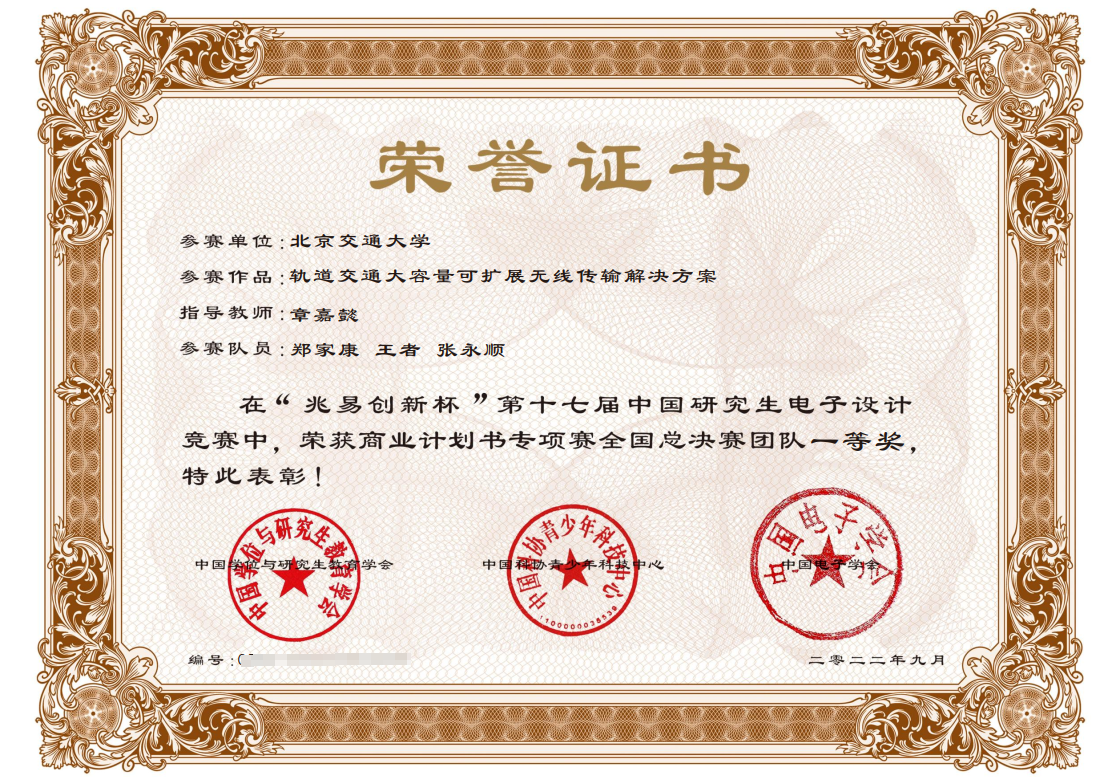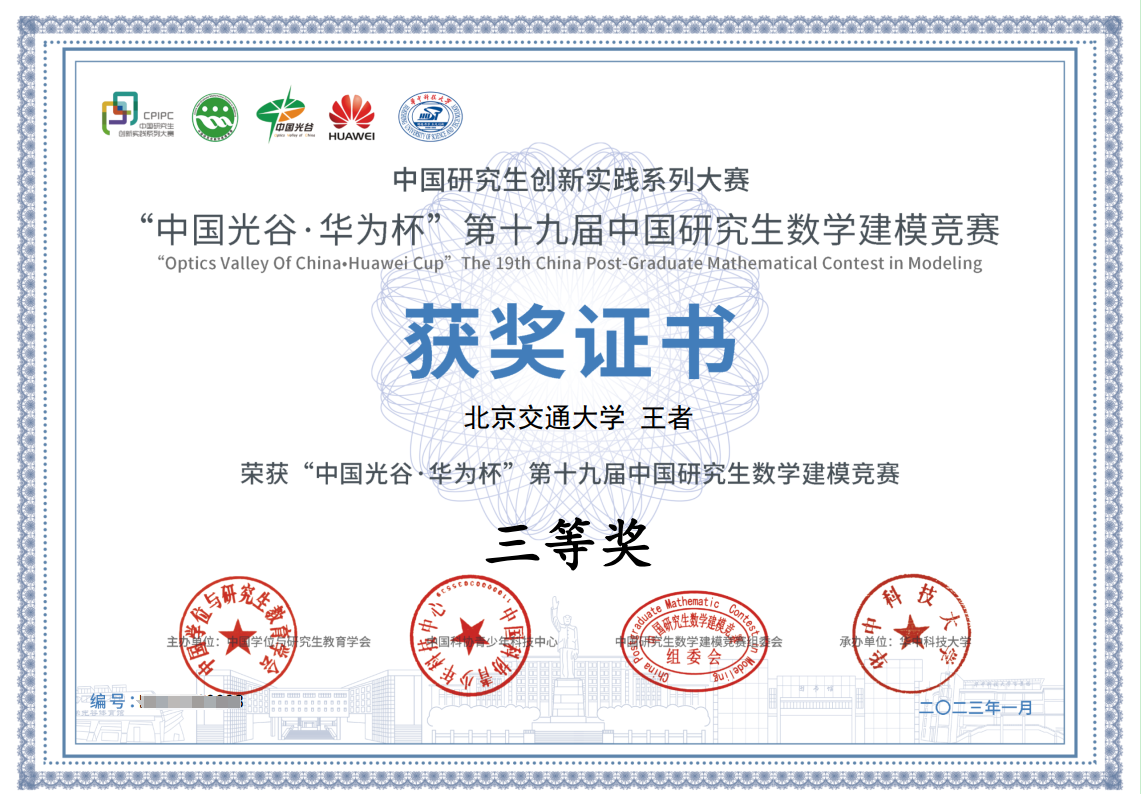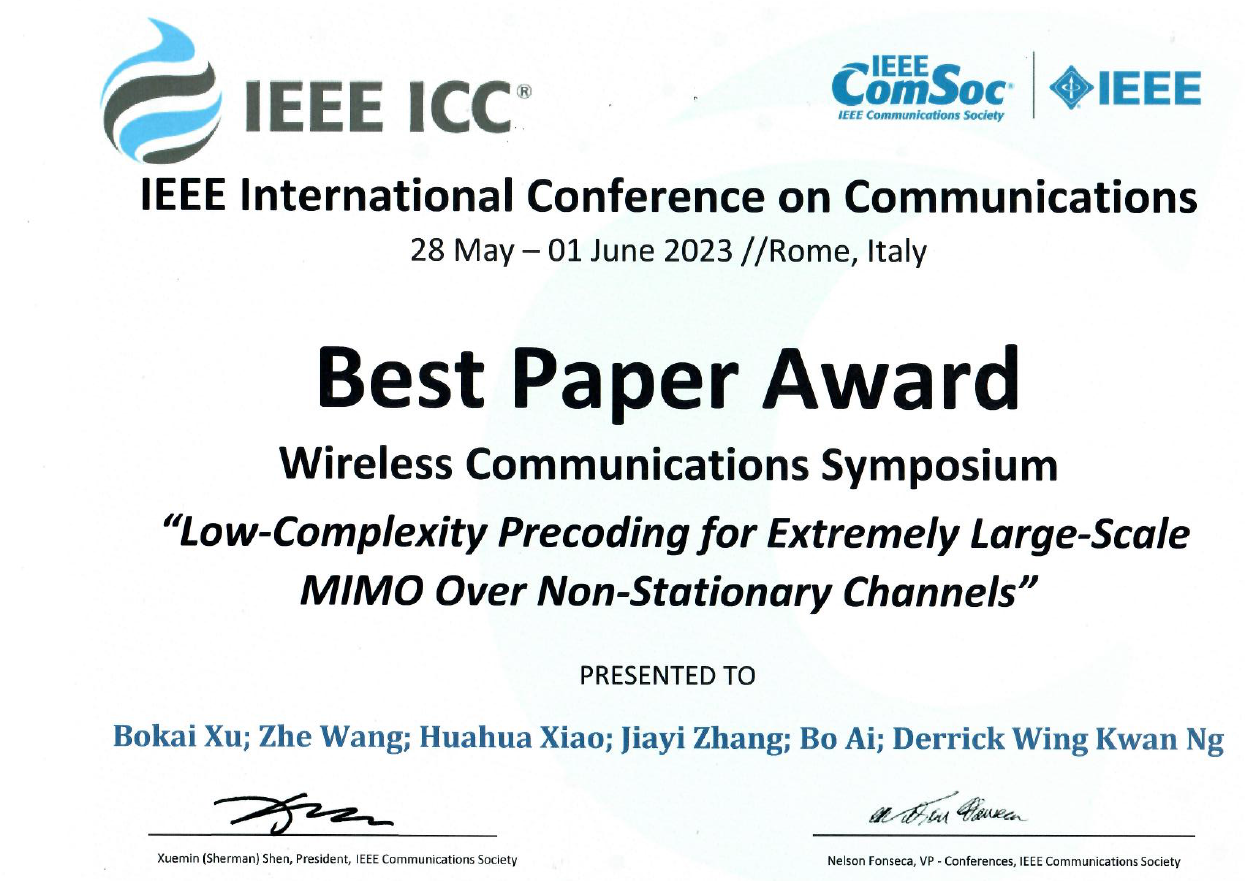Sitemap
A list of all the posts and pages found on the site. For you robots out there is an XML version available for digesting as well.
Pages
Posts
Future Blog Post
Uploaded:
This post will show up by default. To disable scheduling of future posts, edit config.yml and set future: false.
Blog Post number 4
Uploaded:
This is a sample blog post. Lorem ipsum I can’t remember the rest of lorem ipsum and don’t have an internet connection right now. Testing testing testing this blog post. Blog posts are cool.
Blog Post number 3
Uploaded:
This is a sample blog post. Lorem ipsum I can’t remember the rest of lorem ipsum and don’t have an internet connection right now. Testing testing testing this blog post. Blog posts are cool.
Blog Post number 2
Uploaded:
This is a sample blog post. Lorem ipsum I can’t remember the rest of lorem ipsum and don’t have an internet connection right now. Testing testing testing this blog post. Blog posts are cool.
Blog Post number 1
Uploaded:
This is a sample blog post. Lorem ipsum I can’t remember the rest of lorem ipsum and don’t have an internet connection right now. Testing testing testing this blog post. Blog posts are cool.
award
portfolio
publications
Uplink Performance of Cell-Free Massive MIMO Over Spatially Correlated Rician Fading Channels
Published: IEEE Communications Letters
We analyze the uplink spectral efficiency for CF mMIMO systems over spatially correlated Rician fading channels. This channel is practical due to the consideration of phase-shift and spatial correlation. We investigate the uplink spectral efficiency (SE) with maximum ratio (MR)/local minimum mean squared error (LMMSE) combining and optimal large-scale fading decoding based on the phase-aware MMSE, phase-aware element-wise MMSE, and linear MMSE (LMMSE) estimators.

Citation: Zhe Wang, Jiayi Zhang, Emil Björnson, and Bo Ai, “Uplink Performance of Cell-Free Massive MIMO Over Spatially Correlated Rician Fading Channels,” IEEE Communications Letters, vol. 25, no. 4, pp. 1348–1352, Apr. 2021.
Paper Link: https://arxiv.org/pdf/2110.05796.pdf
Uplink Performance of Cell-Free Massive MIMO with Multi-Antenna Users Over Jointly-Correlated Rayleigh Fading Channels
Published: IEEE Transactions on Wireless Communications
We study four uplink implementations for CF mMIMO systems with multi-antenna users, from fully centralized processing to fully distributed processing. We observe that the system performance may not always benefit from the number of antennas per user.

Citation: Zhe Wang, Jiayi Zhang, Bo Ai, Chau Yuen, and Mérouane Debbah, "Uplink Performance of Cell-Free Massive MIMO with Multi-Antenna Users Over Jointly-Correlated Rayleigh Fading Channels," IEEE Transactions on Wireless Communications, vol. 21, no. 9, pp. 7391–7406, Sep. 2022.
Paper Link: https://arxiv.org/pdf/2110.04962.pdf
Uplink Precoding Design for Cell-Free Massive MIMO with Iteratively Weighted MMSE
Published: IEEE Transactions on Communications
To further improve the SE performance for CF mMIMO systems with multi-antenna UE, we design the uplink precoding schemes based on the weighted sum SE maximization. Since the weighted sum SE maximization problem is not jointly over all optimization variables, two efficient uplink precoding schemes based on I-WMMSE algorithms are proposed for two processing schemes investigated.

Citation: Zhe Wang, Jiayi Zhang, Hien Quoc Ngo, Bo Ai, and Mérouane Debbah, “Uplink Precoding Design for Cell-Free Massive MIMO with Iteratively Weighted MMSE,” IEEE Transactions on Communications, vol. 70, no. 3, pp. 1646-1664, Mar. 2023.
Paper Link: https://arxiv.org/pdf/2301.02417.pdf
Low-Complexity Precoding for Extremely Large-Scale MIMO Over Non-Stationary Channels
Published: International Conference on Communications (ICC) 2023
We investigate a low-complexity precoding algorithm, e.g., randomized Kaczmarz (rKA), taking into account the spatial non-stationary properties in XL-MIMO systems. Furthermore, we propose a novel mode of randomization, i.e., sampling without replacement rKA (SwoR-rKA), which enjoys a faster convergence speed than the rKA algorithm. Besides, the closed-form expression of SE considering the interference between subarrays in downlink XL-MIMO systems is derived.

Citation: Bokai Xu, Zhe Wang, Huahua Xiao, Jiayi Zhang, Bo Ai, and Derrick Wing Kwan Ng, “Low-Complexity Precoding for Extremely Large-Scale MIMO Over Non-Stationary Channels,” International Conference on Communications (ICC), 2023.
Paper Link: https://arxiv.org/pdf/2302.00847.pdf
Extremely Large-Scale MIMO: Fundamentals, Challenges, Solutions, and Future Directions
Published: IEEE Wireless Communications
To illustrate the differences and similarities among these schemes, we comprehensively review existing XL-MIMO hardware designs and characteristics in this article. Then, we thoroughly discuss the research status of XL-MIMO from channel modeling, performance analysis, and signal processing. Several existing challenges are introduced and respective solutions are provided. We then propose two case studies for the hybrid propagation channel modeling and the effective degrees of freedom (EDoF) computations for practical scenarios.
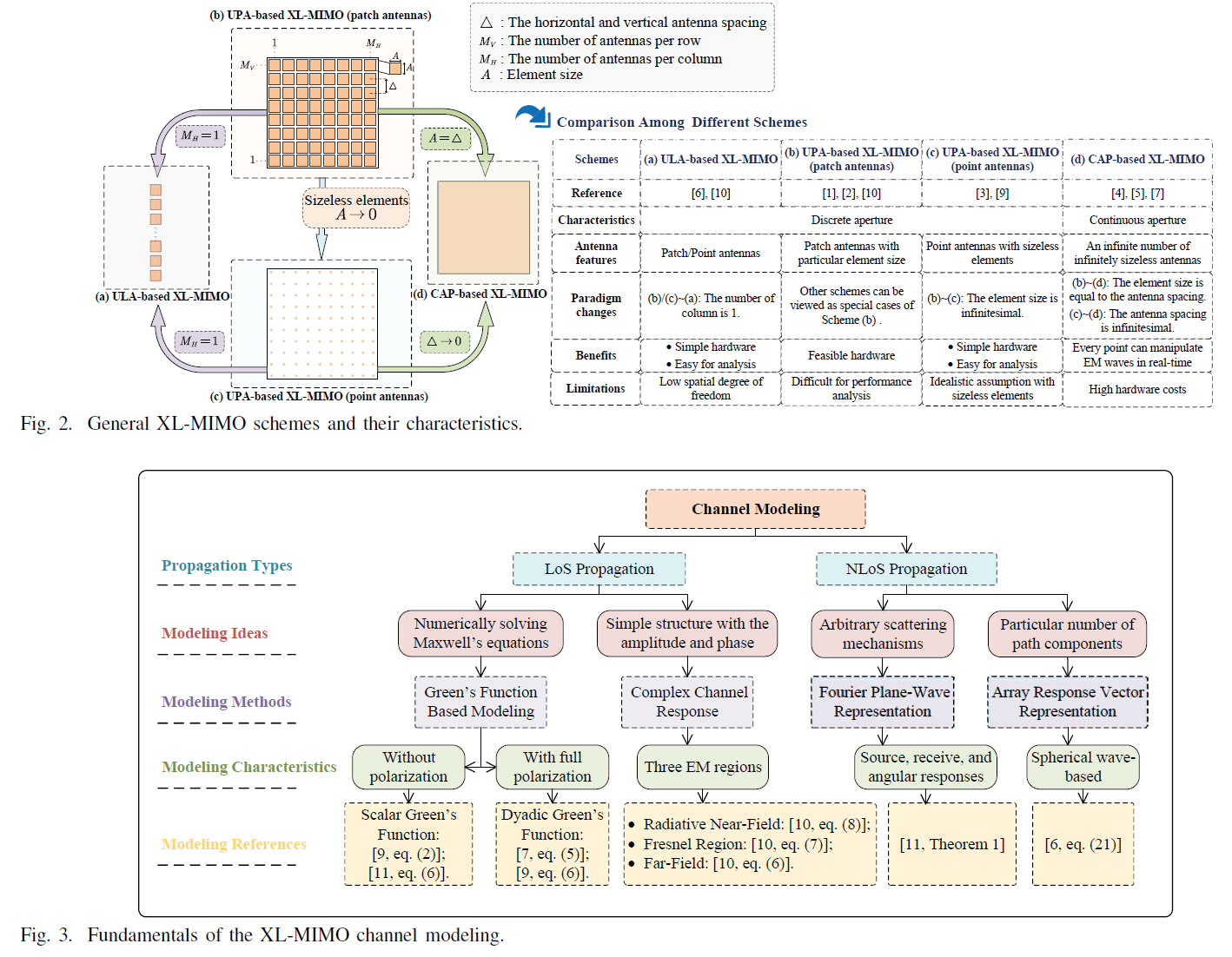
Citation: Zhe Wang, Jiayi Zhang, Hongyang Du, Wei E. I. Sha, Bo Ai, Dusit Niyato, and Mérouane Debbah, "Extremely Large-Scale MIMO: Fundamentals, Challenges, Solutions, and Future Directions," IEEE Wireless Communications, accepted, 2023.
Paper Link: https://arxiv.org/pdf/2209.12131.pdf
Cell-Free XL-MIMO Meets Multi-Agent Reinforcement Learning: Architectures, Challenges, and Future Directions
Published: IEEE Wireless Communications
In this article, we first review the essential opportunities and challenges induced by XL-MIMO systems. We then propose the enhanced paradigm of cell-free XL-MIMO, which incorporates multi-agent reinforcement learning (MARL) to provide a distributed strategy for tackling the problem of high-dimension signal processing and costly energy consumption.

Citation: Zhilong Liu, Jiayi Zhang, Ziheng Liu, Hongyang Du, Zhe Wang, Dusit Niyato, Mohsen Guizani, and Bo Ai, "Cell-Free XL-MIMO Meets Multi-Agent Reinforcement Learning: Architectures, Challenges, and Future Directions," IEEE Wireless Communications, accepted, 2023.
Paper Link: https://arxiv.org/pdf/2307.02827.pdf
A Tutorial on Extremely Large-Scale MIMO for 6G: Fundamentals, Signal Processing, and Applications
Published: IEEE Communications Surveys & Tutorials
We provide a comprehensive survey for XL-MIMO technology, including hardware design, channel modeling, signal processing, application scenarios, and future research directions. It is worth noting that the low-complexity signal processing schemes and deep learning empowered signal processing schemes are reviewed and highlighted to promote the practical implementation of XL-MIMO.
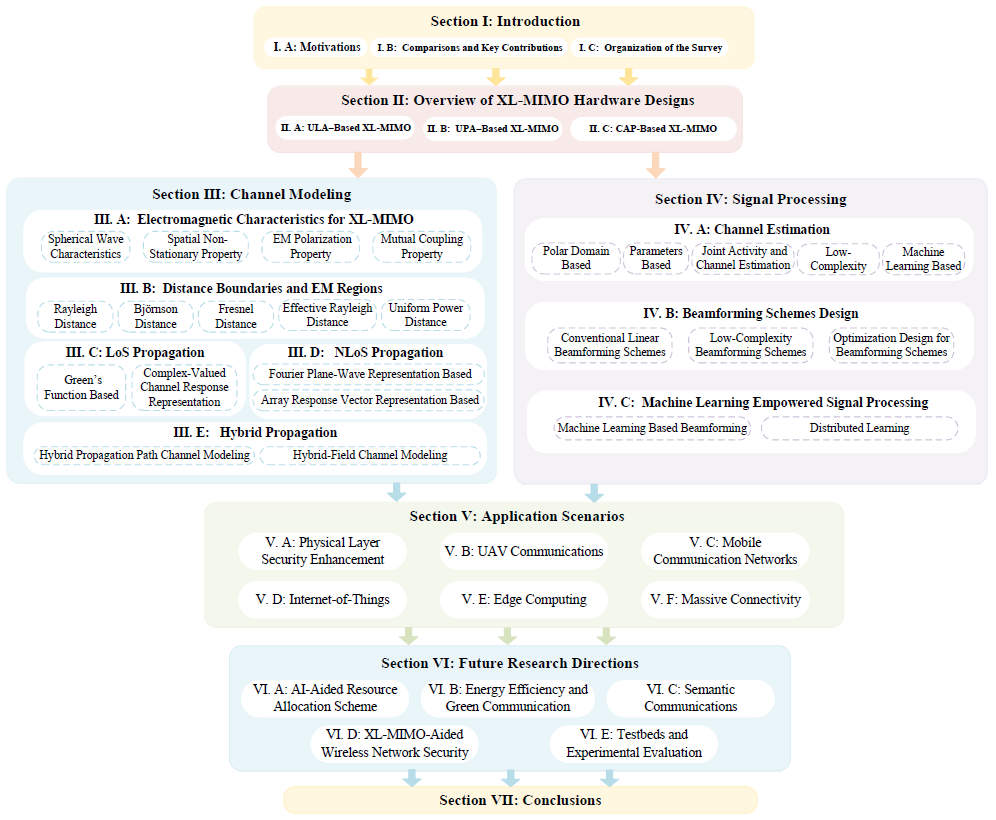
Citation: Zhe Wang, Jiayi Zhang, Hongyang Du, Dusit Niyato, Shuguang Cui, Bo Ai, Mérouane Debbah, Khaled B. Letaief, and H. Vincent Poor, "A Tutorial on Extremely Large-Scale MIMO for 6G: Fundamentals, Signal Processing, and Applications," IEEE Communications Surveys & Tutorials, accepted, 2024.
Paper Link: https://arxiv.org/pdf/2307.07340.pdf
Resource Allocation for Near-Field Communications: Fundamentals, Tools, and Outlooks
Published: IEEE Wireless Communications
We review the basic properties of near-field communications and focus on the corresponding “resource allocation” problems. First, we identify available resources in near-field communication systems and highlight their distinctions from far-field communications. Then, we summarize optimization tools, such as numerical techniques and machine learning methods, for addressing near-field resource allocation, emphasizing their strengths and limitations. Finally, several important research directions of near-field communications are pointed out for further investigation.

Citation: Bokai Xu, Jiayi Zhang, Hongyang Du, Zhe Wang, Yuanwei Liu, Dusit Niyato, Bo Ai, and Khaled B. Letaief, “Resource Allocation for Near-Field Communications: Fundamentals, Tools, and Outlooks,” IEEE Wireless Communications, accepted, 2024.
Paper Link: https://arxiv.org/pdf/2310.17868.pdf
Hybrid-Field Channel Estimation for XL-MIMO Systems with Stochastic Gradient Pursuit Algorithm
Published: IEEE Transactions on Signal Processing
We introduce two stochastic gradient pursuit (SGP)-based schemes for the XL-MIMO hybrid-field channel estimation in two scenarios. For the first scenario in which the prior knowledge of the specific proportion of the number of near-field and far-field channel paths is known, the scheme can effectively leverage the angular-domain sparsity of the far-field channels and the polar-domain sparsity of the near-field channels such that the channel estimation in these two fields can be performed separately. For the second scenario in which the proportion is not available, we propose an off-grid SGP-based channel estimation scheme, which iterates through the values of the proportion parameter based on a criterion before performing the hybrid-field channel estimation.
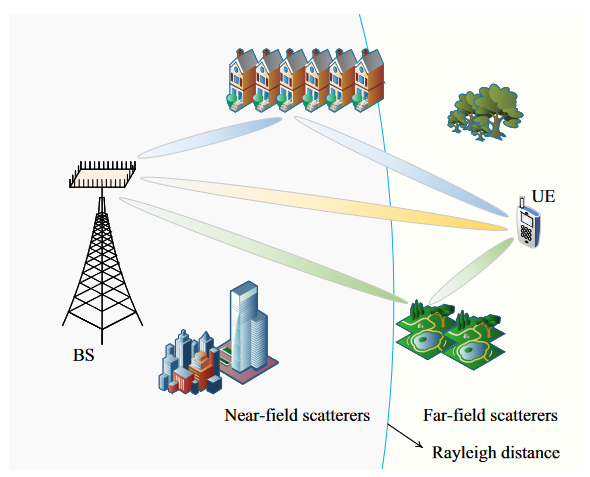
Citation: Hao Lei, Jiayi Zhang, Zhe Wang, Bo Ai, and Derrick Wing Kwan Ng, “Hybrid-Field Channel Estimation for XL-MIMO Systems with Stochastic Gradient Pursuit Algorithm,” IEEE Transactions on Signal Processing, accepted, 2024.
Paper Link: https://arxiv.org/pdf/2405.15345
Near-Field User Localization and Channel Estimation for XL-MIMO Systems: Fundamentals, Recent Advances, and Outlooks
Published: IEEE Wireless Communications
This paper delineates the distinctions between near-field and far-field propagation, highlighting the unique EM characteristics introduced by having large antenna arrays. It thoroughly examines the challenges these new near-field characteristics pose for user localization and channel estimation and provides a comprehensive review of new algorithms developed to address them.

Citation: Hao Lei, Jiayi Zhang, Zhe Wang, Huahua Xiao, Bo Ai, and Emil Björnson, "Near-Field User Localization and Channel Estimation for XL-MIMO Systems: Fundamentals, Recent Advances, and Outlooks," IEEE Wireless Communications, accepted, 2024.
Paper Link: https://arxiv.org/pdf/2407.10147
Analytical Framework for Effective Degrees of Freedom in Near-Field XL-MIMO
Published: IEEE Transactions on Wireless Communications
We develop an effective degrees of freedom (EDoF) performance analysis framework specifically tailored for near-field XL-MIMO systems. We explore five representative distinct XL-MIMO hardware designs, including uniform planar array (UPA)-based with point antennas, two-dimensional (2D) continuous aperture (CAP) plane-based, UPA-based with patch antennas, uniform linear array (ULA)-based, and one-dimensional (1D) CAP line segment-based XL-MIMO systems. Our analysis encompasses two near field channel models: the scalar and dyadic Green’s function-based channel models.

Citation: Zhe Wang, Jiayi Zhang, Wenhui Yi, Hongyang Du, Dusit Niyato, Bo Ai, and Derrick Wing Kwan Ng, "Analytical Framework for Effective Degrees of Freedom in Near-Field XL-MIMO," IEEE Transactions on Wireless Communications, accepted, 2025.
Paper Link: https://arxiv.org/pdf/2401.15280.pdf
Optimal Bilinear Equalizer for Cell-Free Massive MIMO Systems over Correlated Rician Channels
Published: IEEE Transactions on Signal Processing
We explore the low-complexity optimal bilinear equalizer (OBE) combining scheme design for cell-free massive multiple-input multiple-output networks with spatially correlated Rician fading channels. We propose one centralized and two distributed OBE schemes: Centralized OBE (C-OBE), Distributed OBE based on Global channel statistics (DG-OBE), and Distributed OBE based on Local channel statistics (DL-OBE), which maximize their respective SE expressions. OBE matrices in these schemes are tailored based on varying levels of channel statistics.

Citation: Zhe Wang, Jiayi Zhang, Emil Björnson, Dusit Niyato, Bo Ai, "Optimal Bilinear Equalizer for Cell-Free Massive MIMO Systems over Correlated Rician Channels," IEEE Transactions on Signal Processing, accepted, 2025.
Paper Link: https://arxiv.org/pdf/2407.18531
submitted
Generative AI Agent for Next-Generation MIMO Design: Fundamentals, Challenges, and Vision
Uploaded: arXiv
We study generative artificial intelligence (AI) agent-enabled next-generation MIMO design. Firstly, we provide an overview of the development, fundamentals, and challenges of the next-generation MIMO. Then, we propose the concept of the generative AI agent, which is capable of generating tailored and specialized contents with the aid of large language model (LLM) and retrieval augmented generation (RAG). Next, we comprehensively discuss the features and advantages of the generative AI agent framework. More importantly, to tackle existing challenges of next-generation MIMO, we discuss generative AI agent-enabled next-generation MIMO design, from the perspective of performance analysis, signal processing, and resource allocation.

Citation: Zhe Wang, Jiayi Zhang, Hongyang Du, Ruichen Zhang, Dusit Niyato, Bo Ai, and Khaled B. Letaief, "Generative AI Agent for Next-Generation MIMO Design: Fundamentals, Challenges, and Vision," 2404.08878, 2024.
Paper Link: https://arxiv.org/pdf/2404.08878.pdf
talks
Talk 1 on Relevant Topic in Your Field
Uploaded: UC San Francisco, Department of Testing
This is a description of your talk, which is a markdown files that can be all markdown-ified like any other post. Yay markdown!
Tutorial 1 on Relevant Topic in Your Field
Uploaded: UC-Berkeley Institute for Testing Science
Conference Proceeding talk 3 on Relevant Topic in Your Field
Uploaded: Testing Institute of America 2014 Annual Conference
This is a description of your conference proceedings talk, note the different field in type. You can put anything in this field.
teaching
Teaching experience 1
Undergraduate course, University 1, Department, 2014
This is a description of a teaching experience. You can use markdown like any other post.
Teaching experience 2
Workshop, University 1, Department, 2015
This is a description of a teaching experience. You can use markdown like any other post.

